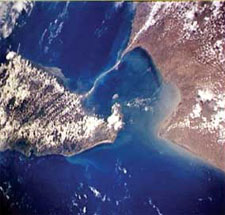|
Ram Setu: Setu bandh is created by Lord Ram by the help of two expert marine  architect Nala and Nila. Nala and Nila made a nearly floating bridge within a very short time, by coral reefs. 1,750,000 years old Ram Setu Space images taken by NASA reveal a mysterious ancient bridge in the Palk Strait between India and Sri Lanka. The recently discovered bridge currently named as Adam's Bridge is made of chain of shoals, 30km long. The bridge's unique curvature and composition by age reveals that it is man made. Loose sand under the bridge and the varying breath signify, it is man made. architect Nala and Nila. Nala and Nila made a nearly floating bridge within a very short time, by coral reefs. 1,750,000 years old Ram Setu Space images taken by NASA reveal a mysterious ancient bridge in the Palk Strait between India and Sri Lanka. The recently discovered bridge currently named as Adam's Bridge is made of chain of shoals, 30km long. The bridge's unique curvature and composition by age reveals that it is man made. Loose sand under the bridge and the varying breath signify, it is man made.
Adam's Bridge also known as Rama's Bridge or Ram Setu
(Sanskrit), is a chain of limestone shoals, between the
islands of Rameswaram, off the southeastern coast of
Tamil Nadu, India, and Mannar, near northwestern Sri
Lanka. Geological evidence indicates that this bridge is
a former land connection between India and Sri Lanka.
The bridge is 30 miles (48 km) long and separates the
Gulf of Mannar (southwest) from the Palk Strait
(northeast). Some of the sandbanks are dry and the sea
in the area is very shallow, being only 3 ft to 30 ft (1
m to 10 m) deep in places, which hinders navigation.
Ramayana and scriptures mention about the floating
stones used by Hanuman and other Vanara Sena to build
the Ram Setu connecting India and Srilanka at Rameswaram.
In this show, you will see the original stones picked up
from Ram Setu and the scientfic validation.
Here are certain points from Valmiki Ramayan to be
considered: There is no other book than Ramayan that has
put into scriptures describing such geographical
constructs. Ramayan says that it was build under the
supervision of an Architect Nala – son of the greatest
Architect of all times ‘Vishwakarma’ (Note:
‘Vishwakarma’ is a designation given to the greatest
archeologist and builder of the era in ancient Hindu
society, a similar practice as we have in modern world
of ‘Nobel Prize’). Thus, the book makes sure that such a
bridge can be constructed by only architect of highest
skill. What seems to be mythical to the Historians and
Science is the concept of Monkey building the Bridge.
But they forget to expand the vision on this, purely
because of their biased attitude to defeating Hindu
faith. We all know now that there are many species that
do not exist now and the largest known to human is
Dinosaur. Why can’t different specie exist around 1
million years ago with the capacity of human
intelligence and monkey like physical structure –
something that was called as Vanars in those days?
Science do not forget to mention that man evolved out of
monkeys – but defeats Hindus to consider that Vanars
were the in between form of the evolution the evidence
present in those days. But no view would consider this,
simply because then the religion of peace would win
then. Yet, there is no doubt that evolution theory is
again a controversial theory existing and taught to
people, without any scientific evidence around it. No
historian can deny the fact that there is a coincidence
and only one coincidence between a reality and its
occurrence in a book called Ramayan. Instead, of now
having set a direction to find out how such thing took
place, these catholic followers are simply applying all
forces and theories to falsify a fact. Yet the presence
of shoals below the bridge and their type indicate that
they cannot be found in sea in the manner it exists at
Ram Sethu.
A
team from the Centre for Remote Sensing (CRS) of
Bharathidasan University, Tiruchi led by Professor S.M.
Ramasamy in 2003 claimed that, "Rama's bridge could only
be 3,500 years old" and, "as the carbon dating of the
beaches roughly matches the dates of Ramayana, its link
to the epic needs to be explored". However, one needs to
note that the surveys which have come out with the
3500-year age for the bridge are based on the studies
conducted on corals grown on the bridge itself and it
has been argued that this represents only the age of
what was measured, which is the corals. The bridge
underneath the corals has been dated back to hundreds of
thousands of years earlier. A former director of the
Geological Survey of India, S. Badrinarayanan, claims
that such a natural formation would be impossible. He
justifies the same by the presence of a loose sand layer
under corals for the entire stretch. Corals normally
form above rocks. He feels that thorough analysis was
not conducted by the Geological Survey of India before
undertaking the SSCP project. In connection with the
canal project, the Madras High Court in its verdict
stated that the Rama Sethu is a man-made
structure.Geological and archaeological findings of Teri
formations, a rich assemblage of Mesolithic-Microlithic
tools and human fossils found on both sides of the
bridge by the Department of Earth-Science in March 2007
are also quoted as evidence for manmade structure.
"Vast, well-constructed, magnificent with its wonderful
paved floor, solidly cemented, that great causeway like
unto a line traced on the waves, resembled the parting
of a woman's hair"
|








